
Here you can study for the exam. Look up keywords and learn definitions about all kind of subjects.
More subjects
The Cesky Terrier (/ˈtʃɛski/ CHES-kee; Czech: Český teriér, lit. 'Bohemian Terrier' or 'Czech Terrier') is a small terrier type dog originating in Czechoslovakia. The Cesky Terrier is a well-muscled, short legged, well-pigmented, hunting terrier of a rectangular format. The Cesky has natural drop ears, a natural tail, and sports a long, silky with slight texture coat in shades of gray from charcoal to platinum (black pigmented) or rarely brown (liver pigmented). The Cesky is longer than it is tall and has a topline that rises slightly to the rear. (Source: Wikipedia.org, CC BY-SA)
The Chesapeake Bay Retriever is a large breed of dog belonging to the retriever, gundog, and sporting breed groups. The breed was developed in the United States Chesapeake Bay area during the 19th century. Historically used by local market hunters to retrieve waterfowl, pull fishing nets, and rescue fishermen, it is today primarily a family pet and hunting companion, known for a bright and happy disposition; courage; willingness to work; alertness; intelligence; love of water; and hunting capabilities. The Chesapeake is a medium- to large-sized dog similar in appearance to the Labrador Retriever, but with a wavy coat. (Source: Wikipedia.org, CC BY-SA)
The Chihuahua or Spanish: Chihuahueño is a Mexican breed of toy dog. It is named for the Mexican state of Chihuahua and is among the smallest of all dog breeds. It is usually kept as a companion animal or for showing. Chihuahuas are the smallest breed recognized by some kennel clubs. Current breed standards defined by registries specify an 'apple-head' or 'apple-dome' skull conformation. Chihuahuas occur in virtually any color combination, from solid to marked or splashed. Apple-dome Chihuahuas have large, round eyes and large, erect ears, set in a high, dramatically rounded skull. The stop is well defined, forming a near-90-degree angle where the muzzle meets the skull. Dogs of the older 'deer' type, with a flat-topped head, more widely set eyes, larger ears, and longer, more slender legs, may still be registered, but the deer head is not considered a separate type in competition and a deer-head dog's digression from the breed standard is considered a fault. (Source: Wikipedia.org, CC BY-SA)
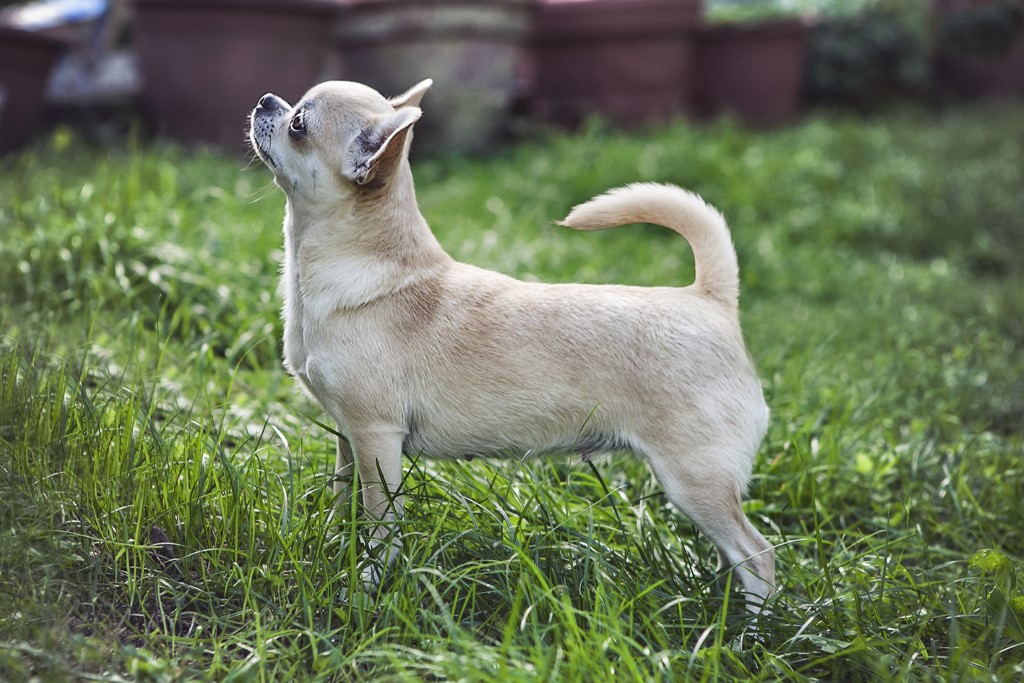 © Wikimedia.org/Caterinarufo, CC0
© Wikimedia.org/Caterinarufo, CC0
The Chilean Terrier is the first breed of dog from Chile. The breed dates back to the late 19th century, resulting from the crossing of the Smooth Fox Terrier with the Ratonero Bodeguero Andaluz. This dog is recognised by the Kennel Club of Chile (KCC), but is not recognized by the FCI. Since 2011, the breed is classified into Group 3 of Alianz Canine Worldwide (ACW). Its main color is white, which is accompanied by black and brown markings. It has a shorthaired undercoat that sometimes hints at some dark spots visible through the white mantle. The ears are set high with a forward-leaning as a 'V' tip. It has a well-developed teeth and bite. Males have a height of between 32 and 38 cm tall at the withers, the ideal height being 35 cm. Females have a height of between 28 and 35 cm tall at the withers, being the ideal height of 32 cm males weigh between 5 and 8 kg, ideal weight is 6.5 kilos. females weigh between 4 and 7 kg, and the ideal weight is 5.5 kg. (Source: Wikipedia.org, CC BY-SA)
 © Wikimedia.org, CC0
© Wikimedia.org, CC0
The Chinese Crested Dog is a hairless breed of dog. Like most hairless dog breeds, the Chinese Crested Dog comes in three varieties, with hair, without hair and a combination of the two, which can be born in the same litter: the Powderpuff, the Hairless and the Hairy-Hairless. The Chinese Crested is considered a small breed, weighing on average 10–13 lb (4.5–5.9 kg). At first look, the Hairless and Powderpuff varieties of Chinese Crested Dogs appear to be two different breeds, but hairlessness is an incomplete dominant trait within a single breed. The Hairless has soft, humanlike skin, as well as tufts of hair on its paws ('socks') and tail ('plume') and long, flowing hair on its head ('crest'). In addition to being an incomplete dominant gene, the 'hairless' gene has a prenatal lethal effect when homozygous. Zygotes affected with double hairless genes never develop into puppies, and are reabsorbed in the womb. All Hairless Chinese Crested Dogs are therefore heterozygous. (Source: Wikipedia.org, CC BY-SA)
The Chinook is a breed of sled dog, developed in the state of New Hampshire during the early 20th century. The Chinook is New Hampshire's official state dog. Standing 21 to 27 inches (53 to 69 cm) in height at the withers and weighing 45 to 90 pounds (20 to 41 kg), the Chinook is balanced and muscular. The United Kennel Club (UKC) breed standard states, 'The ideal coloration runs from light honey color to reddish-gold. Black markings on the inside corners of the eyes are preferred. Dark tawny to black markings on the ears and muzzle are preferred. Guard hairs on the tail may be black. No white markings are allowed. Buff markings on the cheeks, muzzle, throat, chest, breeches, toes and underside are acceptable.' The UKC standard faults any color other than tawny and disqualifies albinism. Other proposed standards state that the medium-length double coat is 'tawny' in color, with darker shadings on muzzle and ears; white dogs are not allowed, nor are other colors. Eyes are brown to amber in color. Ear carriage is variable, but dropped is preferred and the head more strongly rectangular than other sleddog breeds. The tail is a well-furred saber and not the usual brush or plume of Arctic breeds. (Source: Wikipedia.org, CC BY-SA)
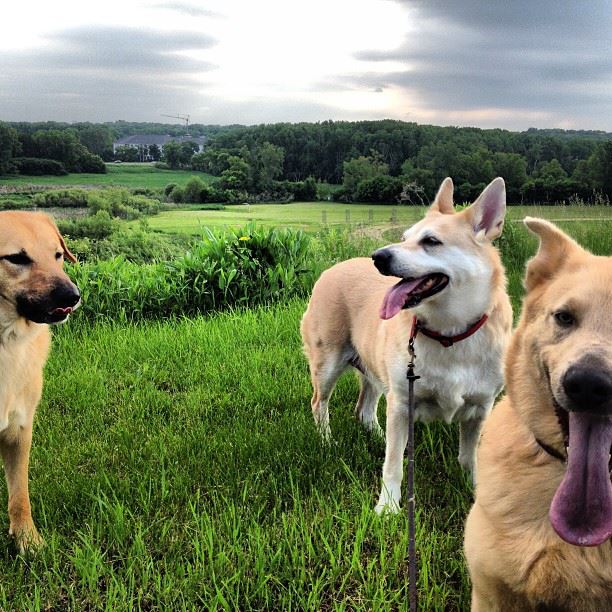 © Wikimedia.org/Kathleen Riley, CC BY-SA
© Wikimedia.org/Kathleen Riley, CC BY-SA
The Chippiparai is a breed of sighthound from the State of Tamil Nadu in southern India. The Chippiparai has typical streamlined sighthound features with long legs and a lean and lithe frame built for speed. The breed is usually white in colour, although other colours can be found. It averages 61 centimetres (24 in) in height at the withers, dogs averaging 63 centimetres (25 in) and bitches 56 centimetres (22 in). A hardy breed, the Chippiparai is reputed to prefer a single master, shunning food and pats from anyone except its handler. The Chippiparai is often regarded as the most intelligent and biddable of India's native dog breeds. (Source: Wikipedia.org, CC BY-SA)
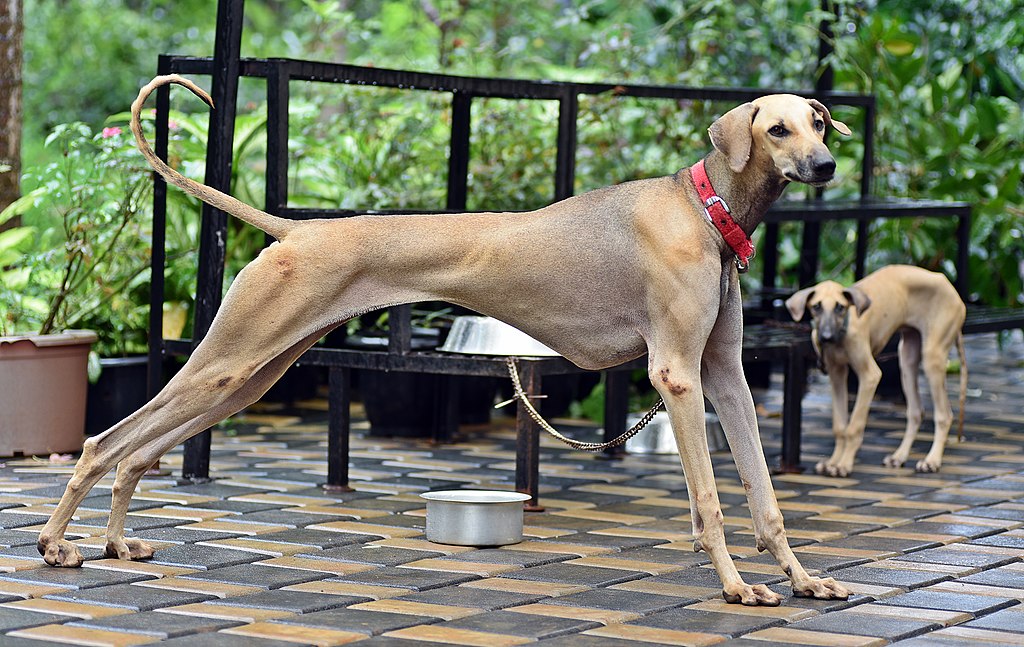 © Wikimedia.org/Pankajakshannair Manoj, CC BY-SA
© Wikimedia.org/Pankajakshannair Manoj, CC BY-SA
The Chongqing dog (Chinese:重庆犬 ) is an ancient mastiff Tugou historically used for hunting and guarding in Chongqing, China. Today this breed is prized as a fearless and tough protector of their family and home. The term 'Chongqing Dog' may also be used to refer to the Chuandong hound. Both dogs share a common foundation stock and are part of the Tugou. Chongqing Dogs are medium sized with compact muscular bodies. Their tail should be short and held upright, often described as a 'bamboo stick'. Their hair coat is short, course and reddish-brown or black in color. They have a blue-black tongue, prominent stop and square head. Their ears are naturally pricked, and not cropped. (Source: Wikipedia.org, CC BY-SA)
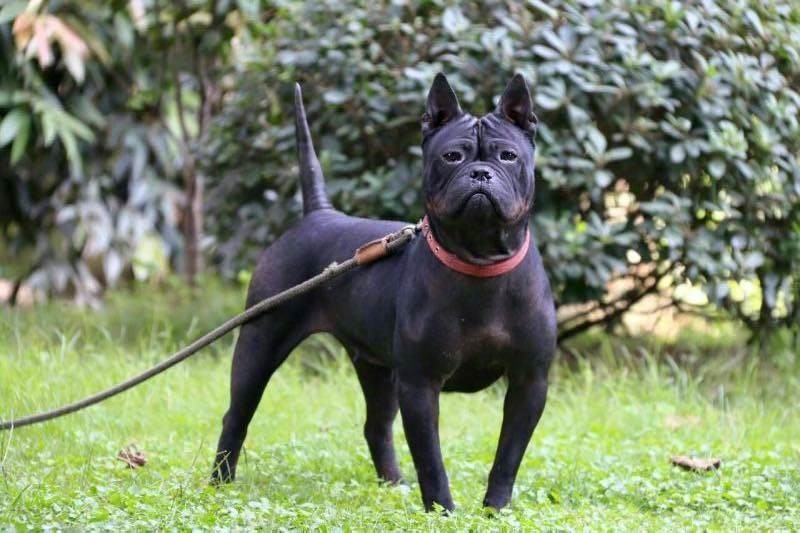 © Wikimedia.org/Markus Monroe, CC BY-SA
© Wikimedia.org/Markus Monroe, CC BY-SA
The Chortai, sometimes spelt Chortaj, is a breed of sighthound from Ukraine. The Chortai is said to resemble a cross between a Greyhound and a short haired Borzoi, being a quite heavily built running hound but nevertheless displaying typical sighthound features. The Chortai is believed to have been developed from the now extinct Krymstaja and Gorskaja breeds and was a favourite breed of the Russian nobility; one was exhibited at the London Zoo in 1829 as a Russian Greyhound although otherwise they have rarely been seen outside their own country. (Source: Wikipedia.org, CC BY-SA)
 © Wikimedia.org/Hortaya, CC BY-SA
© Wikimedia.org/Hortaya, CC BY-SA
The Chow Chow is a spitz-type of dog breed originally from northern China. The Chow Chow is a sturdily built dog, square in profile, with a broad skull and small, triangular, erect ears with rounded tips. The breed is known for a very dense double coat that is either smooth or rough.: 4–5 The fur is particularly thick in the neck area, giving it a distinctive ruff or mane appearance. The coat may be shaded/self-red, black, blue, cinnamon/fawn, or cream.: 4–5 (Source: Wikipedia.org, CC BY-SA)
The Chukotka Sled Dog (Russian: чуко́тская ездова́я, chukótskaya yezdováya, 'Chukotsky riding dog', literally 'riding Chukotsky') is the aboriginal spitz breed of dog indigenous to the Chukchi people of Russia. Chukotka sled dog teams have been used since prehistoric times to pulls sleds in harsh conditions, such as hunting sea mammals on oceanic pack ice. While most famous as the progenitor of the Siberian husky (and related to the Alaskan Malamute), Chukotka Sled Dogs almost died out during the Soviet era due to lack of interest in preserving genetically purebred examples and have only recently made a resurgence. In 1999, the Russian Kynologic Federation (RKF) approved the first official standard of the breed. (Source: Wikipedia.org, CC BY-SA)
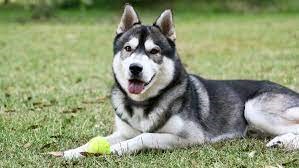 ©
©
The Cimarrón Uruguayo (Uruguayan Cimarrón) is a breed of molosser-type dog originating in Uruguay. Other names by which it is known in English are Cimarrón, Cimarrón Creole, Cimarrón Dog, Maroon Dog, Cerro Largo Dog, Uruguayan Gaucho Dog, Perro Cimarrón, possibly others. The breed is officially recognised in Uruguay and by the Fédération Cynologique Internationale with the name Cimarrón Uruguayo. The Cimarrón Uruguayo is large in size, compact and muscular. The coat is short and usually brindle but may be a pale yellow ('bayo'), with a black face. Height of males at the withers is from 58 to 61 cm (23 to 24 in) and weight is from 38 to 45 kg (84 to 99 lb). Adult females are slightly smaller. (Source: Wikipedia.org, CC BY-SA)
 © Wikimedia.org/Coquimbo58, CC BY-SA
© Wikimedia.org/Coquimbo58, CC BY-SA
The Cirneco dell'Etna is an Italian breed of hunting dog from the Mediterranean island of Sicily. It is named for the Etna volcano in eastern Sicily. It has a keen sense of smell, and is used to hunt small game, particularly rabbits. As with many working dogs, registration is conditional on successful completion of a working trial. (Source: Wikipedia.org, CC BY-SA)
The Clumber Spaniel is a breed of dog of the spaniel type, developed in the United Kingdom. It is the largest of the spaniels, and comes in predominantly white with either lemon or orange markings. The name of the breed is taken from Clumber Park in Nottinghamshire where the breed was first developed. It is a gundog that specialises in hunting in heavy cover. They are gentle and loyal, and can act aloof with strangers. They have several habits which could be considered disadvantages, including a constant shedding of its coat and snoring. (Source: Wikipedia.org, CC BY-SA)
The Colombian Fino Hound (Spanish: Sabueso Fino Colombiano) is a breed of scent hound from Colombia. The Colombian Fino Hound is a medium-sized, short haired, long eared breed which displays many typical scent hound traits. The Asociación Club Canino Colombiano's breed standard states the breed comes in two sizes, the standard size stands between 43 and 50 centimetres (17 and 20 in), whilst the larger grande size stands between 51 and 60 centimetres (20 and 24 in). The breed standard states the standard sized variety weighs between 15 and 25 kilograms (33 and 55 lb) and the grande variety weighs between 25 and 35 kilograms (55 and 77 lb). (Source: Wikipedia.org, CC BY-SA)
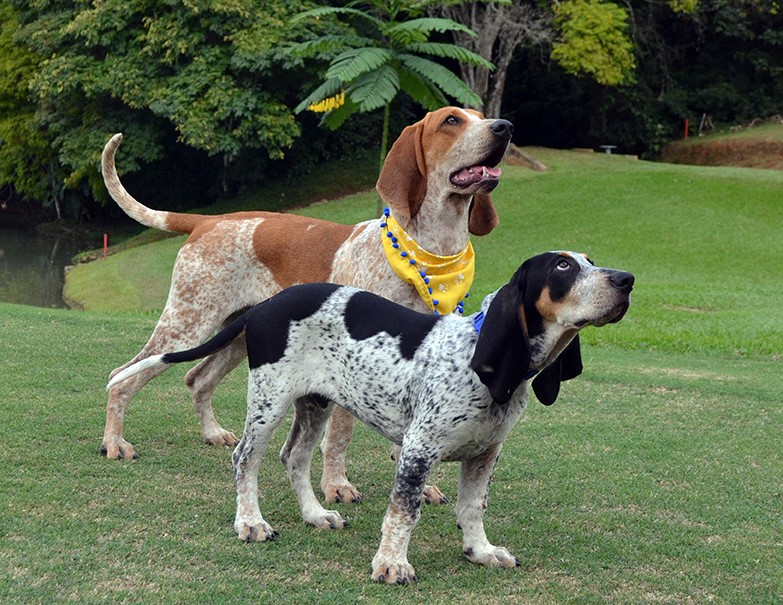 © Wikimedia.org/D1090, CC BY-SA
© Wikimedia.org/D1090, CC BY-SA
The Continental Bulldog, or Conti for short, is a newer dog breed created in Switzerland. It is officially recognized by the FCI since 2022. A smooth-coated, almost square, medium-sized bulldog-type dog of athletic build. Despite his compact body, the Continental Bulldog is mobile and of staying power; his respiration even at full speed is noiseless. His weight, depending on his height, is between 20 and 30 kg. The head is less massive than that of the Bulldog. The forehead is flat to slightly domed, wrinkles existing but not too distinct. The underbite not so pronounced as that in the Bulldog. Short and strong, but not as short as to give the impression that the head sits directly on the shoulders. Well-arched neck line. Regular and fluid movement, good advancement of the forelegs, spacious thrust of the hind legs. The coat is smooth, short, with or without an undercoat. All colours which are accompanied by a dark nose are allowed: self-coloured, brindled or in combination with white, with or without black mask. (Source: Wikipedia.org, CC BY-SA)
The Corsican Dog (chien corse) or Cursinu, is a breed of dog originating from Corsica. It has existed on the island since the 16th century, but went into decline during the late 20th century; however it was saved and became recognized by the Société Centrale Canine. Used for a variety of working purposes, it has no specific health issues. The breed measures 46–58 centimetres (18–23 in) at the withers with male dogs being slightly larger than females. Their coat can be fringed, with usual colors being brindle, fawn, black and tan or brown. The presence of a melanistic mask is permitted under the breed standard. White markings can be on the chest or the legs. The skin of the dog adheres closely to the body, and dewlaps do not appear in the breed. (Source: Wikipedia.org, CC BY-SA)
The Coton de Tuléar is a breed of small dog named for the city of Tuléar (also known as Toliara) in Madagascar. This breed is thought to have originated from a group of small white dogs that swam across the Malagasy channel following a shipwreck. Known for its cotton-like coat, the Coton de Tuléar typically grows to no more than 18 pounds (8.2 kg), and are white, sometimes with grey, tan, black, or tri-colored markings. The Coton de Tuléar Day is celebrated on November 26th. (Source: Wikipedia.org, CC BY-SA)
The Kritikos Lagonikos (Cretan Hound) (Greek:Kρητικός Λαγωνικός) is a breed of dog from the island of Crete, in Greece. The Cretan Hound is recognized both in Greece and in Germany. The breed is also considered to be the oldest European dog breed dating to perhaps before 3200 BCE and Neolithic times. The Cretan Hound is a slender dog, somewhere between a scenthound and a sighthound in body, particularly light on its feet (that are oval rather than cat-like) and strong in loin, specially adopted for swift reflexes and high speed over dangerous, rocky terrain. The head is wedge-shaped, elongated and dry, with pricked and very mobile ears that fold backwards. The tail is a key breed characteristic, long and curved upwards, forming a loose or tight ring and covered with a brush of longer hair underneath. (Source: Wikipedia.org, CC BY-SA)
The Croatian Sheepdog is a dog breed from Croatia. The Croatian sheepdog is of low to medium height and the base color is always black, although there may be very small patches of white on its chest and/or toes.[citation needed] A characteristic is the short hairs on its somewhat fox-like head and legs. The remainder of the coat is longer and wavy or curly. The height at the withers in both sexes is between 16 and 21 inches and the length exceeds the height by approximately 10%. Traditionally the tail is docked very short but, if undocked, it is carried curled over the dog's back.[citation needed] (Source: Wikipedia.org, CC BY-SA)
 © Wikimedia.org/Michala Mračková, CC0
© Wikimedia.org/Michala Mračková, CC0
The Curly-coated Retriever (not always hyphenated, and often called the Curly for short) is a breed of dog originally bred in England for upland bird and waterfowl hunting. It is the tallest of the retrievers and is easily distinguishable by the mass of tight curls covering its body. Curly Coated and Wavy Coated (now known as the Flat-Coated Retriever) were the first two recognised retriever breeds, established as early as 1860. (Source: Wikipedia.org, CC BY-SA)
The Czechoslovakian Wolfdog (Czech: Československý vlčák, Slovak: Československý vlčiak, German: Tschechoslowakischer Wolfhund) is a wolf-dog breed that began as an experiment conducted in Czechoslovakia in 1955. The lowest shoulder height is 65 cm (26 in) for a male and 60 cm (24 in) for a female, and there is no upper limit. The body frame is rectangular, with the ratio of the height to length being 9:10 or less. The minimum weight is 26 kg (57 lb) for males and 20 kg (44 lb) for females. The expression of the head must indicate the sex. Amber eyes set obliquely and short upright ears in a triangular shape are its characteristic features. The set of teeth is complete (42) and very strong; both scissors-shaped and pliers-shaped dentition are acceptable. The spine is straight, strong in movement, with a short loin. The chest is large and flat rather than barrel-shaped. The belly is strong and drawn in. The back is short and slightly sloped; the tail is high set, and when freely lowered reaches the tarsi. The forelimbs are straight and narrow-set, with the paws slightly turned out, with a long radius and metacarpus. The hind limbs are muscular, with a long calf and instep.[citation needed] (Source: Wikipedia.org, CC BY-SA)
The Dalmatian is a breed of dog, which has a white coat marked with black or brown-colored spots. Originating as a hunting dog, it was also used as a carriage dog in its early days. The origins of this breed can be traced back to present-day Croatia and its historical region of Dalmatia. It is thought that early ancestors of the breed were certain breeds of pointers and a spotted Great Dane. Today, it is a popular family pet and many dog enthusiasts enter Dalmatians into kennel club competitions. (Source: Wikipedia.org, CC BY-SA)
A Dandie Dinmont Terrier is a small Scottish dog breed in the terrier family. The breed has a very long body, short legs, and a distinctive topknot of hair on the head. They are friendly but tough, and are suitable for interaction with older children. There are breed-specific health concerns: they can be affected by spinal problems due to their elongated body, and the breed is affected by canine cancer at a higher than average rate. The breed has short legs, with an elongated body. Unusually among Scottish terrier breeds, it has pendulous ears. The neck is muscular, having developed from the breed's use against larger game. The typical height at the withers is 8–11 inches (20–28 cm), and they can weigh anywhere between 18–24 pounds (8.2–10.9 kg). (Source: Wikipedia.org, CC BY-SA)
The Danish Spitz is a dog breed, originating from Denmark. The breed is known for making a good family pet, particularly as they are patient with children. Throughout time they've been known under various names, including Samoyed Spitz, Wolf Spitz, Greenland Spitz and White Spitz, which made it difficult to keep track of the breed and the breeding. Today the breed is known as the Danish Spitz. Their coats occur in white to biscuit colors. The top coat is flat, and sheds in small amounts throughout the year. The undercoat is soft, and keeps them cool in the summer, and warm in the winter; it sheds in the spring and in the fall. The coat of the Danish Spitz is of medium length, and should not stand out from the body. It is slightly longer at the ears, with feathering at the backs of their thighs and legs. The tail should be bushy and carried curled over the back. It is allowed to hang when the dog is calm. (Source: Wikipedia.org, CC BY-SA)
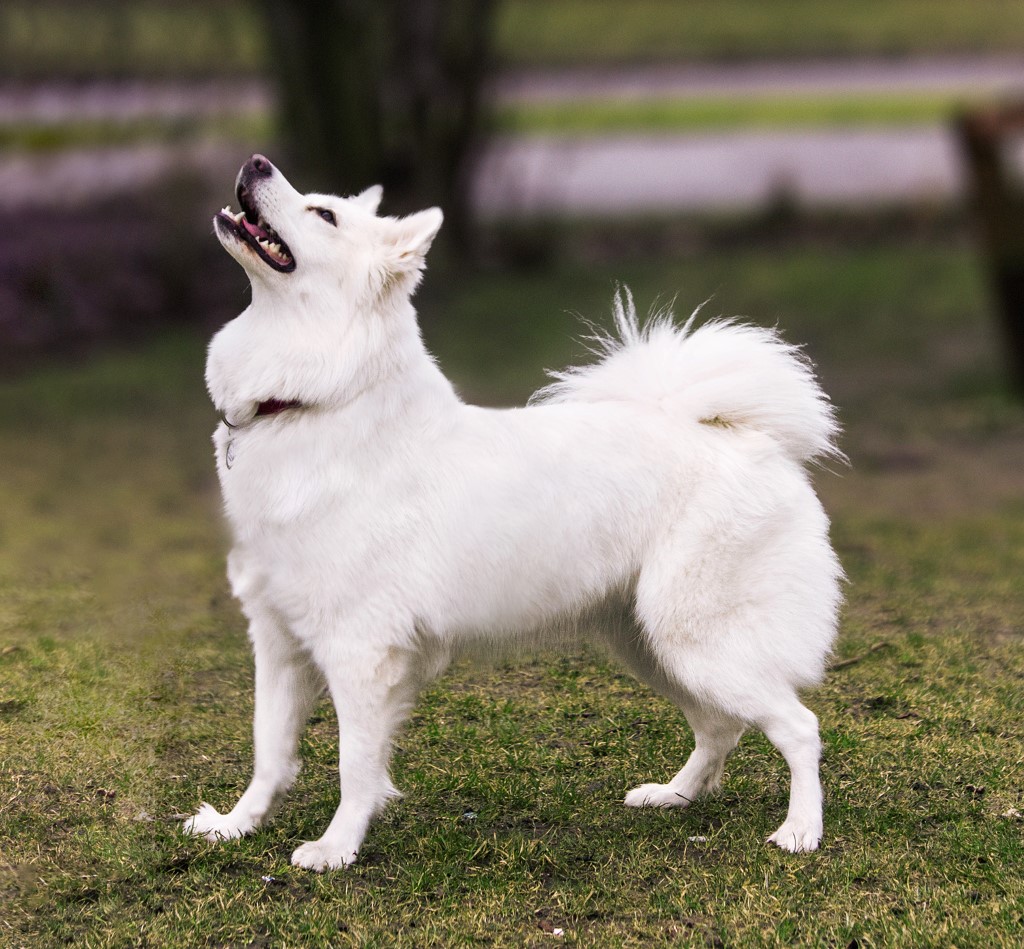 © Wikimedia.org/Charliecatnip, CC BY-SA
© Wikimedia.org/Charliecatnip, CC BY-SA
Danish–Swedish farmdog (Swedish: Dansk-svensk gårdshund, Danish: Dansk/svensk gårdhund) is a breed of dog that has its origin in Denmark and southern Sweden, but has become popular all over Scandinavia. It is a native breed which has historically lived on farms in the eastern part of Denmark and southernmost part of Sweden (i.e. on both sides of Øresund, the narrow strait that separates the Danish island of Zealand from the southern tip of the Scandinavian peninsula), serving as a guard dog, rat catcher and hunting dog. The breed's soft and gentle temperament also makes them excellent companion dogs. There are some indications that the breed originates from the pinscher breeds and the British white hunting terriers. (Source: Wikipedia.org, CC BY-SA)
The dingo (Canis familiaris, Canis familiaris dingo, Canis dingo, or Canis lupus dingo) is an ancient (basal) lineage of dog found in Australia. Its taxonomic classification is debated as indicated by the variety of scientific names presently applied in different publications. It is variously considered a form of domestic dog not warranting recognition as a subspecies, a subspecies of dog or wolf, or a full species in its own right. The dingo is a medium-sized canine that possesses a lean, hardy body adapted for speed, agility, and stamina. The dingo's three main coat colourations are light ginger or tan, black and tan, or creamy white. The skull is wedge-shaped and appears large in proportion to the body. The dingo is closely related to the New Guinea singing dog: their lineage split early from the lineage that led to today's domestic dogs, and can be traced back through the Maritime Southeast Asia to Asia. (Source: Wikipedia.org, CC BY-SA)
The Dobermann (/ˈdoʊbərmən/; German pronunciation: [ˈdoːbɐman]), or Doberman Pinscher in the United States and Canada, is a medium-large breed of domestic dog that was originally developed around 1890 by Louis Dobermann, a tax collector from Germany. The Dobermann has a long muzzle. It stands on its pads and is not usually heavy-footed. Ideally, they have an even and graceful gait. Traditionally, the ears are cropped and posted and the tail is docked. However, in some countries, these procedures are now illegal and it is often considered cruel and unnecessary. Dobermanns have markings on the chest, paws/legs, muzzle, above the eyes, and underneath the tail. Dobermanns are known to be intelligent, alert, and tenaciously loyal companions and guard dogs. (Source: Wikipedia.org, CC BY-SA)
 © Wikimedia.org/Miroslav Cacik, CC0
© Wikimedia.org/Miroslav Cacik, CC0
The Dogo Argentino (plural Dogos Argentinos) is a large, white, muscular breed of dog that was developed in Argentina primarily for the purpose of big-game hunting, including wild boar. The breeder, Antonio Nores Martínez, also wanted a dog that would exhibit steadfast bravery and willingly protect its human companion. It was first bred in 1928 from the Cordoba fighting dog, along with a wide array of other breeds, mainly bulldogs and terriers, including the Great Dane, Dogue de Bordeaux, Pointer, and Bull-and-Terrier. (Source: Wikipedia.org, CC BY-SA)
The Dogue Brasileiro is a mastiff-type working dog breed originating in Brazil. It is neither recognized by the Fédération Cynologique Internationale (FCI) nor the American Kennel Club (AKC). However, it has the official Brazilian recognition by the Brazilian Confederation of Cynophilia (CBKC) where it belongs to the Group 11 – Breeds not recognized by the FCI. The Dogue Brasileiro is a medium-sized, strong, agile and muscular dog, being massive without creating heavy or stocky impression. Males are 54 – 60 cm tall (ideal height 58 cm) and weigh 29 – 43 kg (ideal weight 39 kg); females 50 – 58 cm tall (ideal height 56 cm) and weigh 23 – 39 kg (ideal weight 33 kg). The breed is therefore lighter and athletic, which is equally tall but significantly heavier. There are two coat variants: short (less than 2.5 cm) and medium-length (from 2.5 to 4.7 cm). The texture of the shiny coat is harsh and dense. All colours and combinations are accepted. (Source: Wikipedia.org, CC BY-SA)
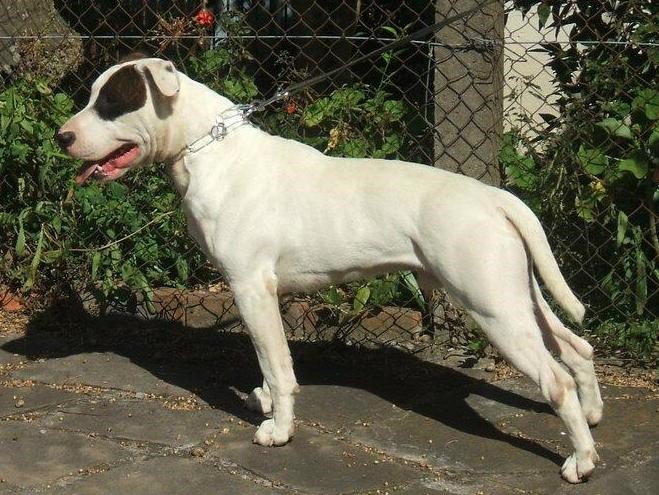 © Wikimedia.org/Thatonka, CC0
© Wikimedia.org/Thatonka, CC0
The Drentsche Patrijshond is a versatile spaniel-type hunting dog from the Dutch province of Drenthe. Called the Dutch Partridge Dog (or 'Drent' for Drenthe) in English, approximately 5,000 dogs are registered with the breed club in the Netherlands, and breed clubs operate in Belgium, Denmark, Scandinavia and North America. The Drentsche Patrijshond bears some resemblance to both spaniel and setter types of dog. An excellent pointer and retriever, this dog is often used to hunt fowl and adapts equally well to the field or marshes. (Source: Wikipedia.org, CC BY-SA)
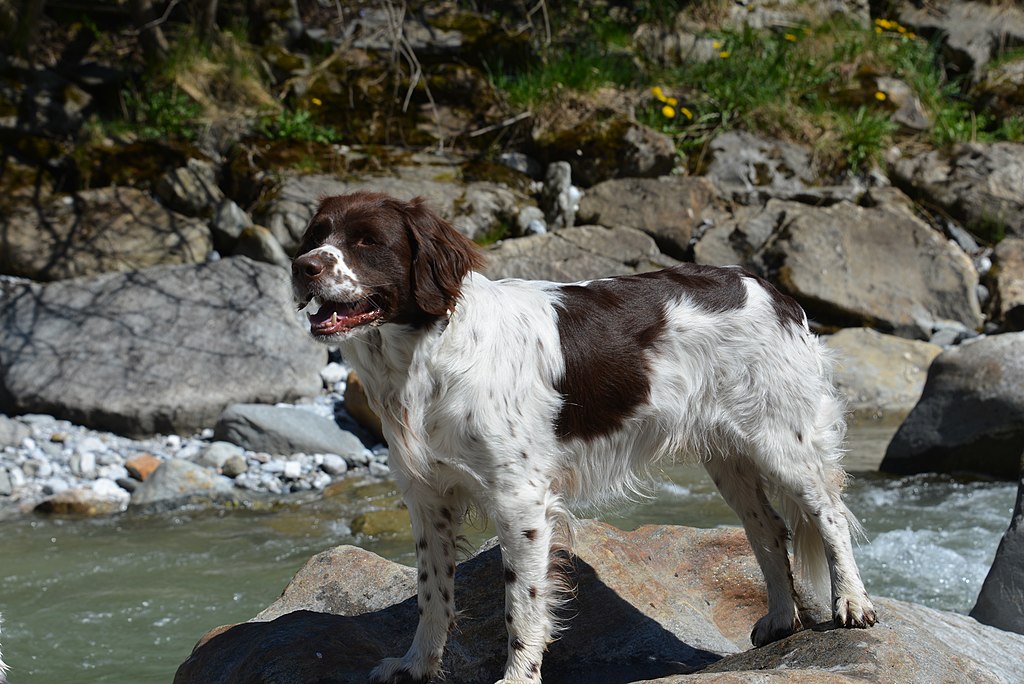 © Wikimedia.org/Stefanie Joksch, CC BY-SA
© Wikimedia.org/Stefanie Joksch, CC BY-SA
The Drever is a breed of dog, a short-legged scenthound from Sweden used for hunting deer and other game. The Drever is descended from the Westphalian Dachsbracke, a type of German hound called Bracke. The breed name Drever was chosen through a contest in 1947. The Drever's most noticeable characteristics are its long body and short legs, inherited from the Westphalian Dachsbracke, but as a working dog these features are not exaggerated. It has short fur, and is of any color with white markings (but not all white, which has been linked to deafness.) The breed has the typical drop (hanging) ears of a hound, and a long tail. The maximum height of a Drever is 38 cm (15 ins) at the withers, which is about 15 cm (approx. 6 ins) shorter than a long legged hunting hound with the same size body. The Westphalian Dachsbracke is about 2 cm (less than an inch) shorter than the Drever. (Source: Wikipedia.org, CC BY-SA)
 © Wikimedia.org/Volbu1, CC BY-SA
© Wikimedia.org/Volbu1, CC BY-SA
A Dunker, also known as the Norwegian Hound, is a medium-sized breed of dog from Norway. It was bred by Wilhelm Dunker to be a scenthound by crossing a Russian Harlequin Hound with dependable Norwegian scent hounds. It is a very rare dog breed, and most Dunkers are found in Norway and Sweden. On average, 150 puppies from the Dunker breed are born each year. The Dunker has a clean, noble, long head with parallel planes of the skull and muzzle, carried low and not wedge-shaped. Its skull is slightly domed with a defined stop and clean cheeks, the muzzle is long and square-cut with a straight and broad nasal bridge, and its teeth are evenly spaced with a scissor-bite. The Dunker has a black nose with wide nostrils, round, large, and dark eyes, and low-set, wide, flat, ears that hang close to the head and to the middle of the muzzle. (Source: Wikipedia.org, CC BY-SA)
The Dutch Shepherd is a herding dog of Dutch origin. They were used by shepherds and farmers who needed a versatile dog, with few demands, and a dog that was able to adapt to a harsh and meager existence. The Dutch Shepherd on average weigh between 50–70 pounds (23–32 kg) and the height varies between 55–63 cm (approximately 22 to 25 inches tall at the withers). Depending on the coat, the breed can be distinguished as short-haired, long-haired, or rough-haired. (Source: Wikipedia.org, CC BY-SA)
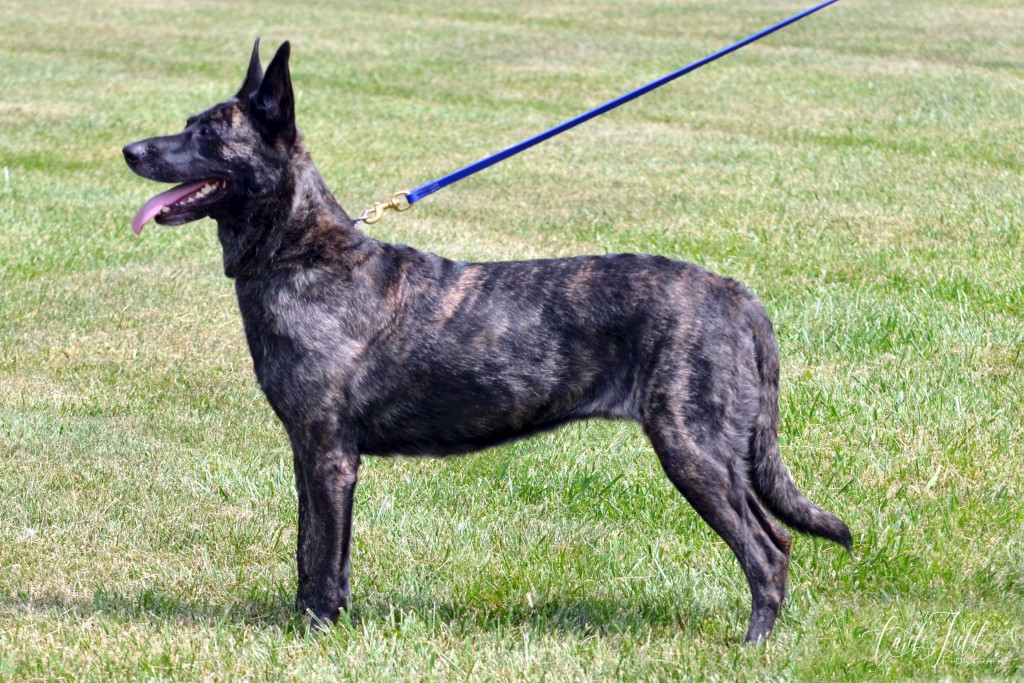 © Wikimedia.org/CaroleField, CC BY-SA
© Wikimedia.org/CaroleField, CC BY-SA
The Dutch Smoushond (Hollandse Smoushond, Dutch Ratter) is a small breed of dog, related to the Pinscher and Schnauzer breed type kept in stables to eliminate rats and mice in Germany and the Netherlands. It is very rare and not well known outside the Netherlands, its country of origin. The Dutch Smoushond is small in size, at the maximum 10 kg in weight and 43 cm at the withers. Its waterproof coat is rough and shaggy, and of any shade of yellow colour. The characteristic shape of the head is broad and short, with drop ears set high on the head. (Source: Wikipedia.org, CC BY-SA)
The East European Shepherd, also called Vostochno Evropeiskaya Ovcharka or VEO (Russian: Восточно-европейская овчарка or ВЕО) is a Soviet Union breed of shepherd dog. It was selectively bred from the German Shepherd to create a larger dog with better resistance to cold conditions, and was intended for military and guard work. The East European Shepherd is significantly larger than the German Shepherd and shows substantial sexual dimorphism: dogs typically stand 67 to 72 cm (26 to 28 in) at the withers although some can be as tall as 74 cm (29 in); bitches are typically 62 to 67 cm (24 to 26 in). The coat is dense and of medium length, with a well-developed undercoat, and often with longer soft hair on the ears, neck, limbs and tail. It may be black-and-tan, sable or solid black; brindles or whites are rare. The eyes may be brown, amber or blue; odd-coloured eyes are known. The ears are long and upright, and the paws are large with long toes, giving a snowshoe-like appearance. (Source: Wikipedia.org, CC BY-SA)
 © Wikimedia.org/Meikel175, CC BY-SA
© Wikimedia.org/Meikel175, CC BY-SA
The East Siberian Laika (Vostotchno-Sibirskaia Laika) is a Russian breed of dog of spitz type, a hunting dog originating in parts of Siberia east of the Yenisei River. Males are 55 to 66 centimetres (22 to 26 in), while females are on the smaller side at 51 to 60 centimetres (20 to 24 in). Black and tan, with light patches (called karamis), grizzle, patched, ticked, white, grey, black, red and brown of all shades. There are two major types, the Evenki and the Irkutsk; other less important types are the Yakutia, Amur and Tofolar. These types vary in color and physique, as the ESL is still more of a diverse conglomerate breed than the other three Russian Laika breeds. Physically the ESL is somewhat rangy, nearly square in proportion, slightly higher at the withers than at the croup, robust in bone; head shape varies with the regional varieties. Ears are erect and triangular, the tail carried in a curve over the back. The coat is a medium long double coat with straight coarse guard hair and a soft thick undercoat. (Source: Wikipedia.org, CC BY-SA)
The English Cocker Spaniel is a breed of gun dog. It is noteworthy for producing one of the most varied numbers of pups in a litter among all dog breeds. The English Cocker Spaniel is an active, good-natured, sporting dog standing well up at the withers and compactly built. There are 'field' or 'working' cockers and 'house' cockers. It is one of several varieties of spaniel and is the foundation of its American cousin, the American Cocker Spaniel. The English Cocker is closer to the working-dog form of the Field Spaniel and the English Springer Spaniel. Outside the US, the breed is usually known simply as the Cocker Spaniel, as is the American Cocker Spaniel within the US. The word cocker is commonly held to stem from their use to hunt woodcocks. The breed can have litters of anywhere from 3 to 12 puppies. (Source: Wikipedia.org, CC BY-SA)
The English Foxhound is one of the four foxhound breeds of dog. It is a cousin of the American Foxhound. They are scent hounds, bred to hunt foxes by scent. The breed standards' guidelines for showing English Foxhounds requires them to be 20–27 inches (51–69 cm) tall at the withers. The skull is thick and the muzzle is long. The legs are muscular, straight-boned, and the paws are rounded, almost cat-like. The English Foxhound comes in any hound color, most often tricolor, tan, red, or black with a white base[citation needed]. (Source: Wikipedia.org, CC BY-SA)
The English Mastiff, or simply the Mastiff, is a British dog breed of very large size. Likely descended from the ancient Alaunt and Pugnaces Britanniae, with a significant input from the Alpine Mastiff in the 19th century. Distinguished by its enormous size, massive head, short coat in a limited range of colours, and always displaying a black mask, the Mastiff is noted for its gentle and loving nature. The lineage of modern dogs can be traced back to the early 19th century, but the modern type was stabilised in the 1880s and refined since. Following a period of sharp decline, the Mastiff has increased its worldwide popularity. Throughout its history the Mastiff has contributed to the development of a number of dog breeds, some generally known as mastiff-type dogs or, confusingly, just as 'mastiffs'. It is the largest living canine, outweighing the wolf by up to 50 kg (110 lbs) on average. (Source: Wikipedia.org, CC BY-SA)
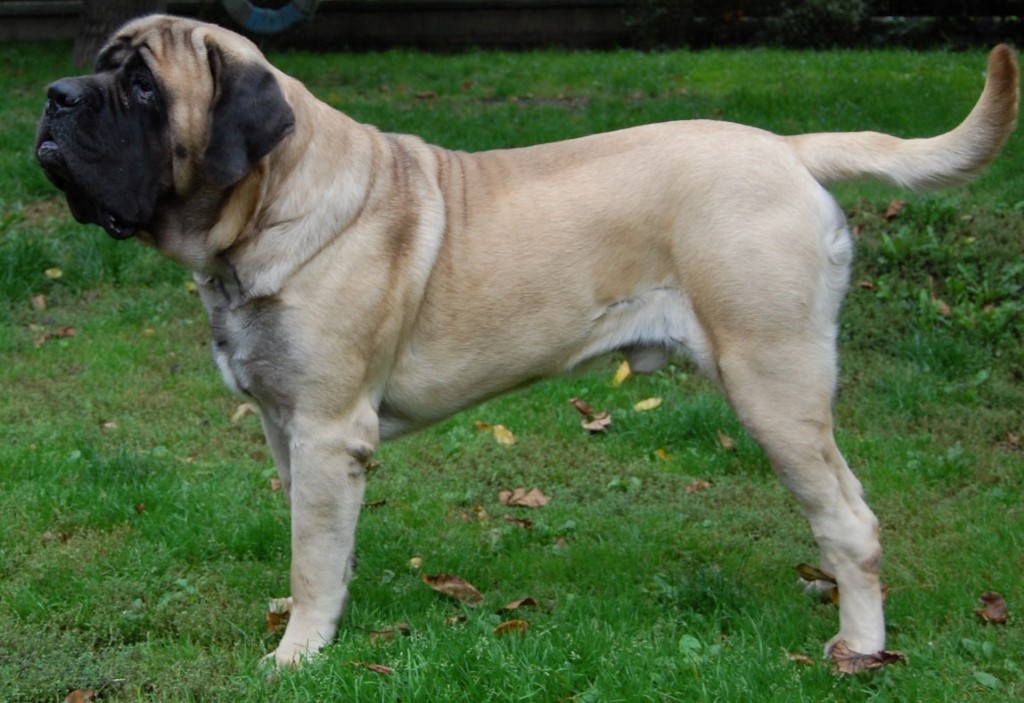 © Wikimedia.org/Radovan Rohovsky, CC BY-SA
© Wikimedia.org/Radovan Rohovsky, CC BY-SA

Time for recess! Post a comment, ask a question or write a review. Feel free to let us know what you think!
look at the sign on the road to avoid accidents and horrible driving conditions
I received a 300$ ticket because I passed a police control of other cars/drivers on the right lane of a highway (the control was on the hard shoulder of the highway). Is it really true, that you have to change the lane in such cases? Thanks!
I am an American living in Italy. The Italian Drivers License theory test is the hardest test I have ever studied for and I am in my 70s have multiple degrees, multiple professional certifications. Have to take the Italian Drivers Theory test in Italian. No english. So many rules. More signs in small medieval Italian town I live in then in major US cities I have lived in. No Italian license no driving. No buying or renting a car. Test here was good, clean. Lots of tricky questions on many practice and real official tests. Thanks
Most problems are a result of higher than safe driving speeds. Please just slow down and be patient.
Question 121: Poor translation: Vehicles with polluted fluids prohibited Should be translated as: Vehicles with dangerous liquids prohibited
Question 83: Poor translation: Vehicles with polluted fluids prohibited Should be translated as: Vehicles with dangerous liquids prohibited
Want even more practice? Visit similar websites offering realistic practice driving knowledge tests. Visit us to see what sets our tests apart! https://dkttest.com/capital-territory/
Cool tool! And fun to check whether I remember the rules :) Two things I noticed: Warning for a crossroad side roads on the left and right. While technically that might be the correct translation, this sign tells you, that you are on the main road and have the right of way for the next crossroad and only the next crossroad. Usually (if no sign specifies otherwise) you have to give way to drivers coming from the right at every intersection, which can get a bit annoying in communal areas, so seeing this sign feels less like a warning and more like relief :). A Fahrradstraße is not a lane for cyclists but a street for cyclists, meaning the (whole!) street is intended predominantly for cyclists, who are then allowed to ride next to each other. Cars are allowed to drive there (unless another sign prohibits such), but have to adjust their speed to the cyclists. I believe they are not allowed to pass at all, even if the oncoming lane is empty.
More community